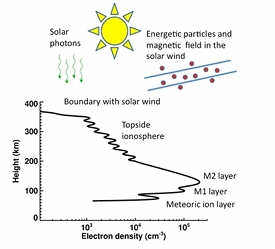Mars Express science highlights:
#8. Mars Express discovers new layer in Martian ionosphere
The MaRS experiment uses the radio signals sent from the spacecraft to Earth to probe the atmosphere and the ionosphere of Mars. The technique, called radio occultation, can be used when the spacecraft disappears behind the planet's disc as seen from Earth.
For a brief period the radio signals pass through the martian ionosphere as they travel between the spacecraft and Earth, providing information about the density of the electrons that compose the ionised layer.
 |
|
Dayside ionosphere of Mars. Image courtesy of P. Withers, Boston University |
During some of these Mars Express occultation seasons, MaRS detected the presence of regions in the atmosphere where the density of electrons was about one tenth of the density of the main ionospheric layer. These regions, localised between 65 and 110 km altitude, unambiguously demonstrated the presence of a third, distinct ionospheric layer beneath the two previously recognised layers situated at 135 km and 110 km altitude.
This newly discovered layer, whose existence was predicted but not previously detected, was found to be discontinuous. It was also observed at different times of the day in different latitudes - early morning and afternoon in the northern hemisphere of the planet, in the equatorial region and at mid-southern latitudes.
The Mars Express radio science team theorised that this layer has a similar origin to a low ionospheric layer found on Earth. This so-called ‘meteoric layer' is created by the fiery destruction of meteors as they enter the upper atmosphere at high speed and burn up. The incineration of the cosmic debris creates magnesium and iron species in the upper atmosphere that further react with the ultraviolet solar flux and the ambient ionosphere – resulting in a distinct ionospheric layer.
On Earth, this lower layer is continuous, but the difference between the two planets’ ionospheres may be explained by the relatively low density of the martian atmosphere. On Mars, meteors have to travel much faster and possess greater kinetic energy to exchange charged particles above 75 km altitude, where the atmosphere becomes really thin. Since fewer meteors arrive with this energy, the meteoric layer in the ionosphere of Mars is non-continuous and appears sporadically.
